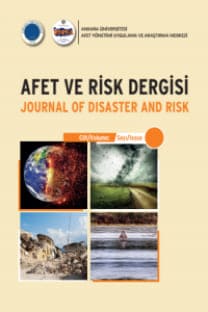An Overview of Landslide Management: Scope, Difficulties, Limitations with Future Directions and Opportunities
Disaster, Management Landslide Hazard, Landslide Management, Landslide Risk, Landslide Susceptibility
An Overview of Landslide Management: Scope, Difficulties, Limitations with Future Directions and Opportunities
Disaster, Management Landslide Hazard, Landslide Management, Landslide Risk, Landslide Susceptibility,
___
- Coutts, C., & Hahn, M. (2015). Green infrastructure, ecosystem services, and human health. International journal of environmental research and public health, 12(8), 9768-9798.
- Dai, F. C., Lee, C. F., & Ngai, Y. Y. (2002). Landslide risk assessment and management: an overview. Engineering geology, 64(1), 65-87. https://doi.org/10.1016/S0013-7952(01)00093-X
- Derin Cengiz, L. & Ercanoglu, M. (2022). A novel data-driven approach to pairwise comparisons in AHP using fuzzy relations and matrices for landslide susceptibility assessments. Environmental Earth Sciences, 81(7), 222. https://doi.org/10.1007/s12665-022-10312-0
- Fan, X., Xu, Q., Scaringi, G., Dai, L., Li, W., Dong, X., ... & Havenith, H. B. (2017). Failure mechanism and kinematics of the deadly June 24th 2017 Xinmo landslide, Maoxian, Sichuan, China. Landslides, 14, 2129-2146. https://doi.org/10.1007/s10346-017-0907-7
- Fell R, Corominas J, Bonnard C, Cascini L, Leroi E, Savage WZ. (2008). Guidelines for landslide susceptibility, hazard and risk zoning for land use planning. Eng Geol. 102(3-4):85–98. https://doi.org/10.1016/j.enggeo.2008.03.022
- Glade, T. (2001). Landslide Hazard Assessment and Historical Landslide Data — An Inseparable Couple?. In: Glade, T., Albini, P., Francés, F. (eds) The Use of Historical Data in Natural Hazard Assessments. Advances in Natural and Technological Hazards Research, vol 17. Springer, Dordrecht. https://doi.org/10.1007/978-94-017-3490-5_12
- Gökçeoğlu, C., & Ercanoğlu, M. (2001). Heyelan duyarlılık haritalarının hazırlanmasında kullanılan parametrelere ilişkin belirsizlikler. Yerbilimleri, 22(23), 189-206.
- Hu, K., Wu, C., Tang, J. et al. New understandings of the June 24th 2017 Xinmo Landslide, Maoxian, Sichuan, China. Landslides 15, 2465–2474 (2018). https://doi.org/10.1007/s10346-018-1073-2
- Ho, K., Leroi, E., & Roberds, B. (2000, November). Quantitative risk assessment: application, myths and future direction. In ISRM International Symposium. OnePetro.
- Kaya, Ç. M. (2022). Taşkın Duyarlılık Haritalarının Oluşturulmasında Kullanılan Yöntemler. Turkish Journal of Remote Sensing and GIS, 3(2), 191-209. https://doi.org/10.48123/rsgis.1129606
- Kremen, C., & Miles, A. (2012). Ecosystem services in biologically diversified versus conventional farming systems: benefits, externalities, and trade-offs. Ecology and society, 17(4).
- Musoke, R., Chimbaru, A., Jambai, A., Njuguna, C., Kayita, J., Bunn, J., ... & Fall, I. S. (2020). A Public health response to a mudslide in Freetown, Sierra Leone, 2017: Lessons Learnt. Disaster medicine and public health preparedness, 14(2), 256-264. https://doi.org/10.1017/dmp.2019.53
- Naiman, R. J., Decamps, H., & McClain, M. E. (2010). Riparia: ecology, conservation, and management of streamside communities. Elsevier.
- Pramova, E., Locatelli, B., Djoudi, H., & Somorin, O. A. (2012). Forests and trees for social adaptation to climate variability and change. Wiley Interdisciplinary Reviews: Climate Change, 3(6), 581-596.
- Sandholz, S., Lange, W., & Nehren, U. (2018). Governing green change: Ecosystem-based measures for reducing landslide risk in Rio de Janeiro. International journal of disaster risk reduction, 32, 75-86.
- Ulusay, R., Aydan, Ö., & Kılıc, R. (2007). Geotechnical assessment of the 2005 Kuzulu landslide (Turkey). Engineering geology, 89(1-2), 112-128.
- URL 1, https://www.who.int/health-topics/landslides#tab=tab_1 Accessed 26 March 2023
- URL 2, https://www.washington.edu/news/2014/07/22/oso-disaster-had-its-roots-in-earlier-landslides/ Accessed 26 March 2023
- URL 3, https://www.usgs.gov/news/featured-story/five-years-later-oso-sr-530-landslide-washington Accessed 26 March 2023
- URL 4, https://www.environmentandsociety.org/arcadia/sidoarjo-mudflow-and-muddiness-environmental-disaster Accessed 26 March 2023
- URL 5, https://www.wired.com/2010/02/mudvolcano/ Accessed 26 March 2023
- URL 6, https://www.bbc.com/news/world-asia-china-40390642 Accessed 26 March 2023
- URL 7, https://www.cepf.net/stories/sierra-leone-mudslide Accessed 26 March 2023
- URL 8, https://www.africanews.com/2022/08/30/sierra-leone-landslide-floods-kill-eight/ Accessed 26 March 2023
- URL 9, https://www.preventionweb.net/news/sierra-leone-climate-disaster-and-crisis-financing-shock-responsive-safety-nets Accessed 26 March 2023
- URL 10, https://edition.cnn.com/2017/08/18/africa/sierra-leone-mudslides/index.html Accessed 26 March 2023
- URL 11, https://www.hurriyet.com.tr/video/koyulhisardaki-heyelan-felaketi-16-yildir-20-milyon-metrekup-topragin-altindalar-41764968 Accessed 26 March 2023
- Varol, N., & Kaya, Ç. M. (2018). Afet Risk Yönetiminde Transdisipliner Yaklaşim. Afet ve Risk Dergisi, 1(1), 1-8. https://doi.org/10.35341/afet.418307
- Vojteková, J., & Vojtek, M. (2020). Assessment of landslide susceptibility at a local spatial scale applying the multi-criteria analysis and GIS: a case study from Slovakia. Geomatics, Natural Hazards and Risk, 11(1), 131-148. https://doi.org/10.1080/19475705.2020.1713233
- Wartman, J., Montgomery, D. R., Anderson, S. A., Keaton, J. R., Benoît, J., dela Chapelle, J., & Gilbert, R. (2016). The 22 March 2014 Oso landslide, Washington, USA. Geomorphology, 253, 275-288. https://doi.org/10.1016/j.geomorph.2015.10.022
- Yilmaz, I., Ekemen, T., Yildirim, M., Keskin, İ., & Özdemir, G. (2006). Failure and flow development of a collapse induced complex landslide: the 2005 Kuzulu (Koyulhisar, Turkey) landslide hazard. Environmental geology, 49, 467-476. https://doi.org/10.1007/s00254-005-0113-0
- Yayın Aralığı: 4
- Başlangıç: 2018
- Yayıncı: Ankara Üniversitesi
112 Acil Sağlık Hizmetleri Çalışanlarının Afetlere Hazırlık Algısı
Fatih OKAN, Sümeyye KAVİCİ PORSUK, Melike YILDIRIM, Buket DURSUN, İlknur TOĞUŞLU, Fatma YANIK
Depreme Yönelik Tutum Ölçeğinin Geliştirilmesi
Yusuf KARAŞİN, Mustafa FİLİZ, Yalçın KARAGÖZ
Yavuz TORAMAN, Fahriye MERDİVENCİ, Makber TEKİN
Determining Levels of Search and Rescue Team’s Knowledge on Avalanche Search and Rescue
Nahsan KAYA, Ezgi ATALAY, Melike DEMİR DOĞAN
Küresel Sorunlar Üzerine Türkiye’de Gerçekleştirilen Lisansüstü Çalışmaların İncelenmesi
Zekeriya Fatih İNEÇ, Devrim KARADENİZ
Sosyal Bilgiler Öğretmen Adaylarının Afetlere Yönelik Tutumlarının İncelenmesi
Düzce Depremi Sonrası Gazete Manşetlerinin Bütünleşik Afet Yönetimi Sürecine Göre Değerlendirilmesi
Sağlık İnanç Modeli’ne Dayalı Acil Durum Afetlere Bireysel Hazırlık ve Bunları Etkileyen Faktörler
Ali ARSLANOĞLU, Mustafa ERDOĞAN, Yalçın DÜDÜKCÜ, Serdal KEÇELİ
Hidro-Meteorolojik Kaynaklı Afetlerin Antalya’daki Mekânsal Yansımaları
